| 1 | Africa’s ruling venomous snake |
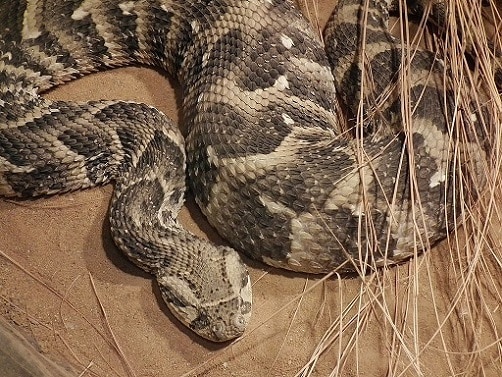
The puff adder is a 80-120cm snake with a dangerously cytotoxic venom. It’s a cunning ambush predator which lurks for weeks in dry, bushy undergrowth, waiting for oblivious rats to wander past. It’s a species which has a 15% fatality in humans if left untreated by antivenom. But more importantly, this species is the most widespread venomous snake in the whole of Africa. By extension, it also has by far the highest annual bite tally, even if it isn’t quite the deadliest species.
The puff adder is ubiquitous in Africa, appearing in almost every country south of the Sahara desert. To the west, they’re found in Ivory Coast, Ghana and Nigeria. To the east, they’re plentiful in Kenya and Ethiopia, while in the southern tip of Africa, they’re a constant presence in South Africa and Zimbabwe. Puff adders are only missing from a few sub-Saharan states: Madagascar (an island), the Seychelles (more islands), Equatorial Guinea (too jungled), and possibly Liberia.
Puff adders also have an overseas colony in Saudi Arabia, Oman, and Yemen, as well as an isolated pocket north of the Sahara in Morocco. In terms of raw headcount, they probably number well into the tens of millions worldwide.
Puff adders are ubiquitous in Africa mainly because of their immense habitat flexibility. You can find this species in grassland, spacious woodlands, farmlands, savannah, and game trails alike. They only really avoid the driest and wettest extremes, e.g. true deserts and rainforests. On a territory map of the puff adder, there’s a gaping whole where the Congo rainforest lies.
| 2 | Dominates African bite statistics |
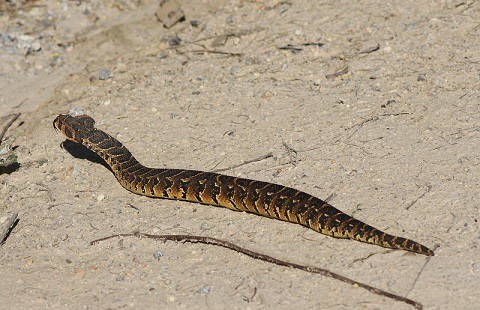
Puff adders don’t have the deadliest venom in Africa, but have one of the highest death tolls by default due to being so common. In Mozambique, a 2022 study revealed them to be the number one cause of snakebite, just ahead of stiletto snakes and well ahead of the infamous black mamba.
A study from Zimbabwe found that among 83 snakebite victims, puff adders were responsible for 75%. Another Zimbabwean study analysed 276 snakebite victims. In 40 cases, the actual species was identified, of which 25 were the puff adder.
Puff adder bites aren’t guaranteed to be fatal, but are more likely to unleash necrosis, sometimes to such severe levels that amputation is necessary. The only saving grace is that unlike cobras, they rarely invade people’s houses. Mozambique spitting cobras can slither through your bedroom window, while puff adders have the deadly feature of lurking on farmland busy with workers.
Puff adders are part of the 16 member Bitis snake genus, which also includes the thick-bodied gaboon adder, famous for its 2.5 inch fangs. Puff adders have slightly shorter fangs, but are easily the most common Bitis member. It’s possible to find them on beaches bordering both the Atlantic ocean to the west and Indian ocean to the east.
| 3 | Venom statistics |
The puff adder is a particularly lazy snake, which can wait for weeks in dry thickets while only occasionally changing position. Local villagers are always stepping on them as they camouflage against foliage near footpaths, and this is another reason for their gigantic bite rate.
As for their venom potency, puff adders don’t quite make the top 20 snakes worldwide, but are more toxic than around two thirds of vipers. With an LD50 score of 0.4mg-2.0mg, they’re more potent than the American cottonmouth (2.08mg), sidewinder rattlesnake (2.6mg), and European meadow viper (2.17mg). The two deadliest vipers worldwide are members of the Indian “big four” snakes: the Russell’s viper (0.4mg) and saw-scaled viper (0.24mg), which the puff adder almost matches.
The puff adder’s brutal symptoms also come from its unusually high venom yield. A thick, stubby body can hold more venom, and puff adders inject an average of 150-300mg per bite. According to some estimates, just 100mg can kill a human being, and the largest, most generous (if that’s the right word) puff adders can inject over 1000mg per bite. Contrast this against the asp viper, France’s main venomous snake, which is equally toxic, but injects only 9-10mg per bite.
Some statisticians rank this species first in annual African snakebite deaths, but others point to the less widespread yet far more vicious black mamba. Puff adders undoubtedly cause far more actual bites than the black mamba, but are significantly less lethal. Only 15% of bites lead to death, and that’s untreated bites as well.
| 4 | Master of impenetrable camouflage |
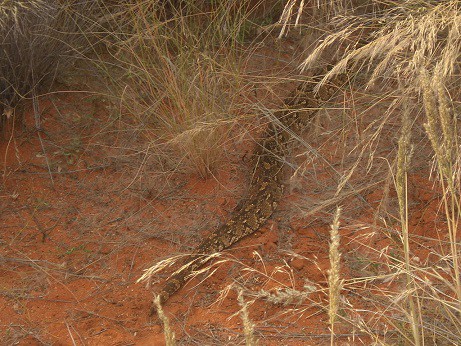
Puff adders average at 1 metre long, and 15-20cm long when born. The Saudi enclave is slightly smaller at 80cm, while the longest African individual on record measured 191cm. With their fat, stubby bodies, they have the illusion of looking even larger.
Yet despite this hefty size, even adult puff adders blend into the dry African undergrowth with ease. The puff adder has some of the most effective camouflage in the whole of Africa, which adds exponentially to their danger. It’s one thing to outrun an angry cobra, but with puff adders, every dry forest or game trail could be a minefield. The hairy bush viper is perfectly designed for camouflage in jungles, but puff adders are unbeatable when it comes to dry, wispy grasses and parched savannah land.
Puff adders have a pale, creamy belly, while their body is brown to dark grey. This is interspersed with beige-coloured lines, which are positioned at distant intervals, like a ribcage spread too far apart. The overall appearance is like a cracked and parched savannah floor.
In thick leaves or a thorny African bush, this snake can be almost invisible to the human eye. This is the kind of snake that appears in a classic online “spot the snake” image, where people sit squinting at pixels, trying to see through its camouflage in a bed of leaves and grass.
| 5 | King of the crushing pounce |
The puff adder is a stealthy ambush snake rather than a manic pursuer, and in dry African bushes, their disguise is virtually impenetrable. They’re normally lethargic, but when a prey species wanders past absentmindedly, they can lunge extremely quickly, in a complete contrast to their usual slow movements. Their Latin title is Bitis arietans, and arietans translates as “to strike violently”.
Puff adders have extremely large fangs which are capable of piercing soft leather. Some rodents die instantly because of the sheer weight and force of the puff adder’s body. These vicious strikes last less than 2 seconds in total, yet the energy packed into them is immense.
As for “puff” adder, this has nothing to do with inflating their necks like a cobra. Instead, it comes from a strange noise they make when confronted by predators, in the rare case that they see through its camouflage. This noise sounds exactly like a puff of air and can be surprisingly loud. It’s a similar noise to the leopard tortoise nearby, leading to a theory that the tortoise is mimicking the far deadlier puff adder to increase its own survival chances (Batesian mimicry).
| 6 | Diet: extremely flexible |
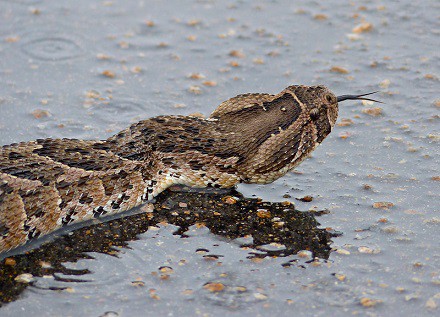
The next stage of the puff adder’s assault depends on the species. With shrews, small mammals, birds, toads, or lizards, they’ll keep a tight hold until the venom works its magic. With larger rodents or rabbits, they’ll stand back and wait for their prey to slowly succumb.
Puff adders are vulnerable to the gnashing, gnawing teeth of larger prey, and need to be cautious. Their diet is as unfussy as can be, leaning towards mammals, but also featuring birds, amphibians and reptiles. One of their confirmed prey is the four-striped grass mouse (Rhabdomys pumilio), an 11cm species with black and white stripes like a skunk. This small mouse inhabits most of southern Africa, particularly gardens, fields and shrublands, which regularly brings it across the puff adder’s path.
In the amphibian kingdom, puff adders regularly dine on African red toads (Schismaderma carens), which look like a strangely shaped clay brick when sitting still. Other meals include the rock mouse (Micaelamys namaquensis), pouched mouse (Saccostomus campestris), and globally ubiquitous black rat.
| 7 | Produces over 100 newborns |
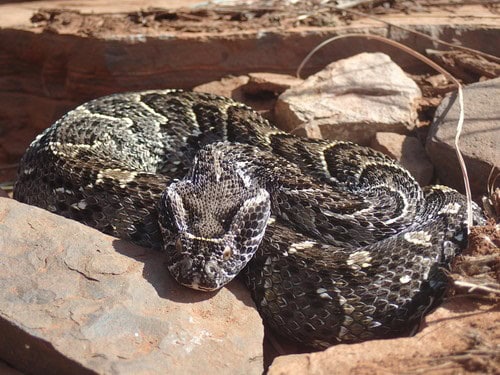
The puff adder is the official holder of one record among snakes: the highest number of newborns at once. The puff adder is ovoviviparous, giving birth to live young, and a Czechoslovakian zoo captive from Kenya once gave birth to 156 at once.
The average is also high, at 20-40 snakes per batch, with 50-60 being perfectly normal, compared to just 2-13 for a scarlet snake in Florida. Supposedly, the puff adder pushes out plenty of unfertilised eggs as well, so if you’ve ever fancied boiled snake eggs for breakfast, then this is the species to track down.
Nobody’s certain how long puff adders live for in the wild. The record in captivity (where the species fares well) was 16 years, so the average in the wild is most likely 10 years. There’s another phenomenon in captivity as well: that the puff adder often gorges itself so full that it dies. This species has no breaks on its hunger; it just eats and eats and eats (and eats) until the plate in front of it is empty, sometimes forcing it to regurgitate whole animals.
| 8 | Lures frogs with its tongue |
Most snakes use their forked tongues for olfactory (smelling) purposes, sniffing out prey species or even subtle changes in atmospheric humidity. But the puff adder’s tongue waggling skills have evolved to a whole other level.
Starting in 2017, biologists gathered 4600 hours of puff adder footage, covering 86 individual snakes, using camera tripods placed in strategic locations around Dinokeng Game Reserve in South Africa.
What they saw amazed them. In multiple instances, they noticed puff adders sticking their tongues out and waggling them around, not briefly, but for extended periods of 30 seconds, after which they’d repeat the cycle again.
Slowly but surely, the biologists would notice frogs creeping into the frame. The puff adder kept up the act in the grainy footage, before the frogs strayed too close and were devoured. The puff adders were using their tongues to lure in prey, by mimicking the appearance of the frog’s own prey. It’s possible that they evolved this trick to compensate for their poor leap distance, which is only 5-10cm. Interestingly, the luring was only used on amphibians and not rodents.
| 9 | Camouflages its own smell |
Luring frogs isn’t the puff adder’s only special hunting technique, as it turned out in 2016 that they camouflage their own smell, as well as their appearance.
A few facts raised the scientists’ suspicions. Firstly, puff adders rarely take shelter underground, despite Africa’s many hungry predators. Secondly, they remain completely still when threatened by predators rather than fighting back. The most suspicious fact was that mongooses and meerkets often walk right past puff adders without noticing them, even stepping over their heads. Puff adders have fantastic visual camouflage, but this seemed to reach another level.
Therefore, the scientists gathered various snake species and gave dogs corresponding scents, in a “scent match” test. The dogs ran to the correct snake in almost all cases, but the puff adder was the exception. The smell left the dogs confused, despite their legendary noses, which are trained to smell illegal drugs and even the adrenaline of stressed criminals fleeing a scene. The puff adders were untraceable, despite only being a few metres away.
This chemical camouflage, known as chemical crypsis, has been detected in the harlequin filefish before, but never a land animal.
| 10 | Even invades beaches |
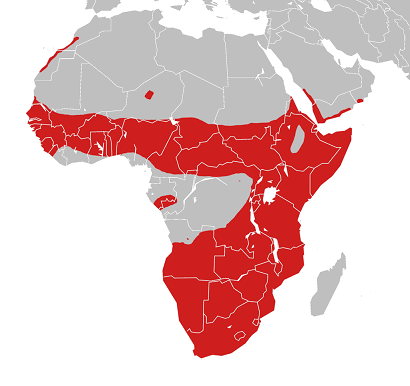
The puff adder looks like the lazy stoner of the snake world, sitting in a bush all day rather than on a sofa with pizza boxes everywhere. But they secretly have a variety of athletic skills, even if they rarely use them. For one thing, they’re excellent tree climbers, which helps them to sniff out unguarded bird eggs.
They’re also excellent swimmers, as witnessed in a news story from May 2017 when a puff adder was spotted swimming across the vast Gariep Dam, near Norvalspont in South Africa. It was surrounded by water on all sides, and was quickly dubbed the Gariep Dam monster. Cameras captured the snake swimming for many kilometres without giving up.
Then in December 2020, a South African family spotted a puff adder floating along a sandy shore in the western Cape. It was the Lundt family’s last trip to the beaches before they all slammed shut due to a new wave of COVID-19. Instead of pristine sparkling ocean, they were greeted by a snake slithering over the water like it was as solid as glass. Puff adders can even curl up into a ball and fall asleep while floating on water.
| 11 | Haemorrhaging rather than paralysis |
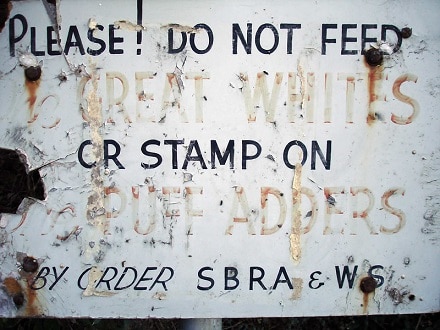
Scientists have identified several rare toxins in puff adder venom including Ba100, bitiscetin, and bitanarin, a post-synaptic neurotoxin. The thrombin-like enzymes (TLEs) have some of the most visible effects. These deactivate fibrogenin in the bloodstream, an important blood-clotting agent, causing watery blood to gush from the bite wound. This is generally a snake of blood chaos, rather than neurotoxic symptoms like drooping muscles (despite containing a few neurotoxins).
Blood blisters are common in victims, as is random spontaneous bleeding. The entry grade systemic symptoms include nausea and vomiting. Puff adder bites are also notorious for causing swollen limbs, due to toxins that massively increase vascular permeability, sending a rush of blood to the bitten body part.
The mildest bites produce only redness and pain, but the unluckiest suffer from necrosis, and the sloughing off of dying tissue, sometimes down to the whiteness of bone. Sometimes, the necrosis is severe enough to cause amputations, changing the victim’s life forever.
Fortunately, antivenom is easily available for puff adders, unlike the secretive hairy bush viper of Kenya, a rare species to have no antivenom developed. As usual in Africa, the main problem is getting the antivenom out to remote villages. This is a snakebite of two halves: the consequences can be dire if untreated, yet at the same time, treating them is quite easy.
| 12 | Eaten by other snakes |
Though equipped with various deadly weapons, puff adders aren’t even close to the top of the serpent pecking order. Fellow snakes often feast on them, including the following confirmed species:
- Black-necked spitting cobras – extremely common in western and central Africa.
- Cape cobra – found mainly in southwest Africa (South Africa, Botswana). See a cool puff adder showdown here.
- Anchiete’s cobra – relatively uncommon, found in northern Namibia and Angola.
- Snouted cobra – a species of southeast Africa (Mozambique, Zimbabwe, southern Namibia).
- Mozambique spitting cobra – the spitter of southeast Africa.
It appears that cobras have a particular liking for puff adder flavours, and this is because of the security granted by their highly neurotoxic venom. Only a cobra can be confident of paralysing a puff adder rapidly enough to not be bitten in the process. It also helps that cobras are particularly fast and nimble as a group.
A cornered puff adder will attempt frantically to escape, accelerating way beyond their usual speed, and sometimes succeeding. But if a cobra lands one bite, then it’s too late, and the puff adder’s fate is inevitable. See this brutal video of a snouted cobra hunting a relatively small puff adder, which went viral in 2020. Other confirmed predators of puff adders include tawny eagles and southern ground hornbills.
| 13 | Colour variation |
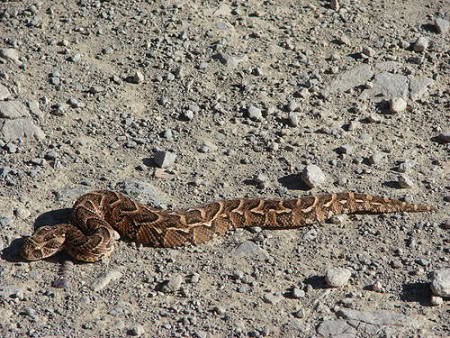
Puff adders have a relatively low variation in appearance, unlike their cousin the horned adder (Bitis caudalis), which has loads of colours. Generally, the image above is as close to a “standard” puff adder as you’ll ever see. However, there are occasional rare morphs, such as this grey speckled version found in Bloemfontein, South Africa.
Puff adders have a slight variation in colour, while generally keeping the same rough patterns. A large chunk are dark grey with paler grey markings, but others can be virtually black contrasting against bright yellow markings. Others have varying shades of beige – these individuals are the ultimate in camouflage. Some puff adders have faded and less distinct markings, while others are vivid and sharply contrasting.
What are the best ID signs for a puff adder? Like most vipers, search for a triangular, bulky head, which is far thicker than the preceding neck. A brutally thick body might be the best ID sign for this snake (see the image above). Another is two large stripes on its face, which cross each eye and make some members look like they’re wearing goggles.
